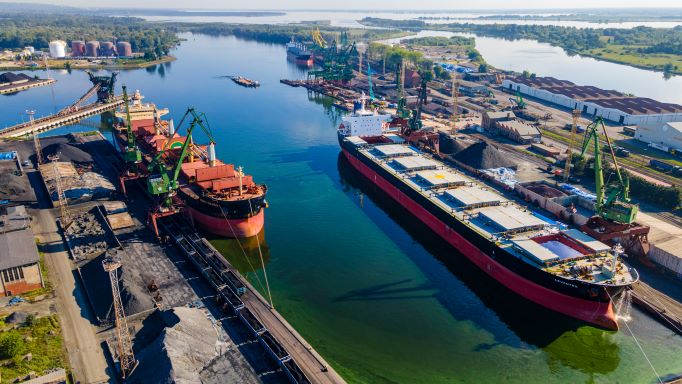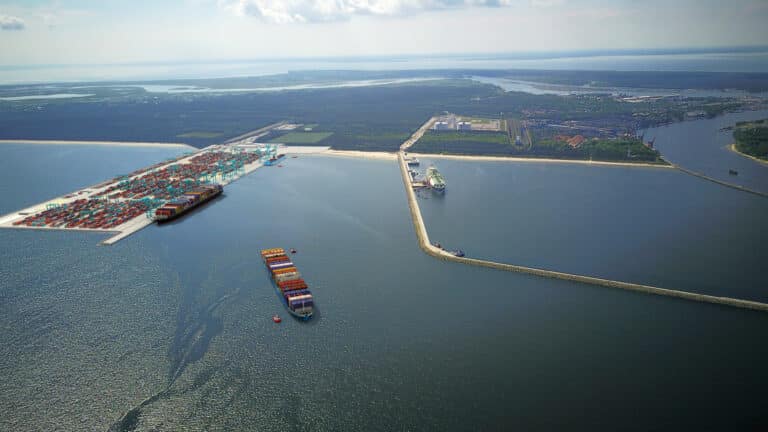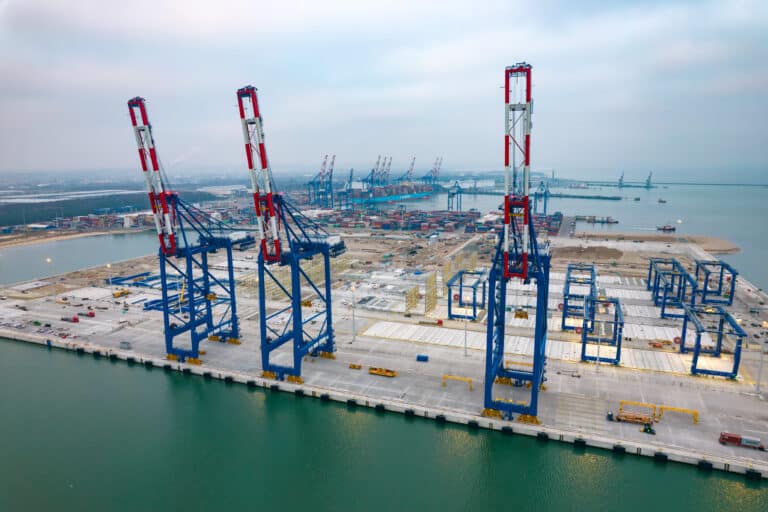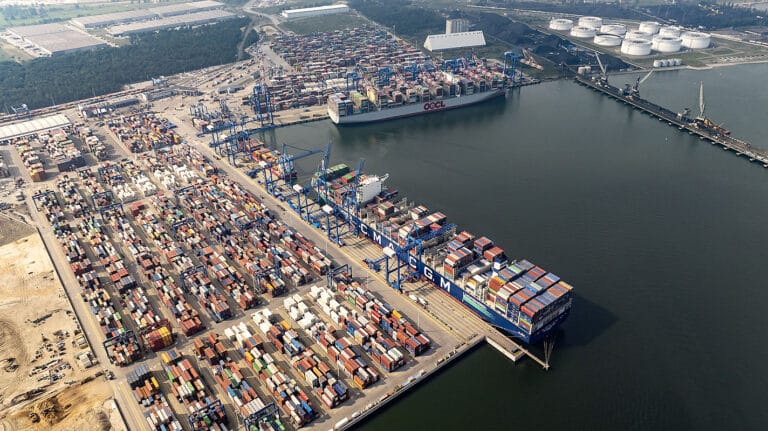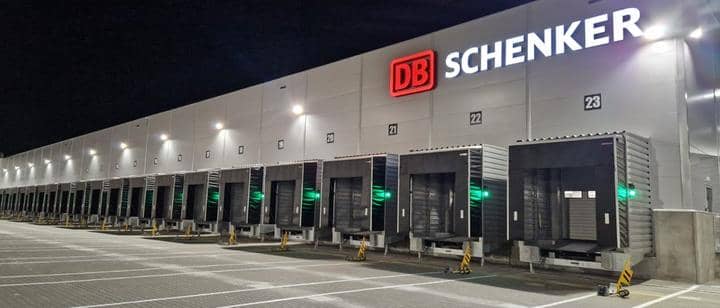Polish ports shine in dark times
Transshipments in Polish ports increased by 18% in 2022, to the highest ever volume of 133 m tonnes, Deputy Minister of Infrastructure Marek Gróbarczyk said on February 13. A year earlier, 113 m tons of goods were handled in Polish ports.
“This record was broken spectacularly,” Grobarczyk said, adding that despite the geopolitical situation, 2022 had been another record year for Polish seaports, with Gdańsk, Gdynia, and the ports of Szczecin and Świnoujście shining a strong light.
Gróbarczyk said that although 2022 had been a little different from other years, due to the war in Ukraine, Polish ports have been reloading more and more goods since last summer. Since 2008, transshipments have increased by 154% from 52.5 m tons.
“I think that the growth rate will be maintained, maybe not at such a high level, but the investments we are making are intended to lead to this development direction, primarily an increase in transshipments, and on the other hand, attracting customers and new commodity groups,” he added.
According to data from the Ministry of Infrastructure, the total value of investments in Polish seaports is PLN 10 bn; approx. PLN 3.13 bn for the Port of Gdańsk, approx. PLN 3.8 bn for the Port of Szczecin-Świnoujście and approx. PLN 3.13 bn for the Port of Gdynia.
Deputy Minister Grzegorz Witkowski, referring to the expected results of the ports in 2023, said “it will be a good year.”
“Polish ports have passed the test (…) in an uneven fight with Putin’s Russia, but all signs indicate that this year will also be a good year for Polish ports, for the Polish maritime economy, and I dare say that this year we will beat not only the Bolsheviks, but also the next transshipments in Polish ports,” he said.
The Vice-President of the Management Board of the Szczecin and Świnoujście Seaports, Daniel Stachiewicz, said that in 2022, a total of 36.8 m tons of goods were handled in these ports. This represents an increase of 10.8% compared to 2021
Stachiewicz added that in 2022, a total of 58 gas carriers docked at the LNG terminal, 23 more than in 2021. They transported 4.4 m tons of gas, i.e. over 6 billion cubic meters. after regasification, 54.6% more than in 2021.
As for other goods, the ports of Szczecin and Świnoujście handled 4.3 m tons of coal (up 50.8%).
The President of the Management Board of the Port of Gdynia, Jacek Sadaj, announced that in 2022, the Port of Gdynia handled 28.1 m tons of goods (in 2022 it was nearly 26.7 million tons). Last year, the port handled 3.4 m tons of coal and coke, an increase of over 174%.
Sadaj added that more and more vessels of ever larger dimensions call at the port of Gdynia. In 2022, a total of 4,331 vessels called at Gdynia (more than 2% more than in 2021). Transports by container ships and bulk carriers also increased. In 2022, more than 1,000 ships arrived at the port (an increase of 8.2%) and nearly 300 ro-ro units (an increase of over 32%).
Port of Gdańsk sees record boost
Over the last 6 years, cargo volumes handled at the Port of Gdańsk have grown 83%, reaching 68.2 m tons in 2022, the highest figure in its history, a year-to-year increase of 28%. The record number was driven mainly by energy material handling.
The President of the Management Board of the Port of Gdansk, Łukasz Greinke, noted that in 2022 the port of Gdańsk became the second largest in the Baltic Sea. The first port is the Russian Ust-Luga (113 m tons). Primorsk is in third place (52.9 m tons) and St. Petersburg (35.6 m tons). The Port of Gdańsk is also the largest container port on the Baltic Sea.
Greinke reported that last year Gdańsk processed 25.5 tons of liquid fuels, an increase of 35.1% year on year. The port also handled 13.2 m tons of coal (up 175.6%). In 2022, the port also handled 1.9 m tons of coal (up 19.9%); wood 548,200 tons (an increase of 413%) and 515,500 tons of ore (an increase of 133.2%).
The president of the port of Gdańsk, referring to the large transshipment of wood, said this was mostly transiting through Poland and comes from other countries, e.g. Scandinavia, the Czech Republic and Slovakia.
Greinke admitted that the port recorded a slight decline – by less than 2% – in the group of containerized general cargo, largely influenced by the introduction of the embargo on goods that were redirected to Russia.
Ports fighting fit
“This was a fantastic year for Polish seaports. The 2021 record for the volume of cargo handled was broken in a spectacular fashion. The cargo handling volumes achieved are clear evidence of just how good the conditions are at Poland’s three largest ports. The total cargo handled by all these facilities was 133 m tons,18% more than the previous year. The embargo on Russian goods has demonstrated how important sea ports are and their critical role in national security. I am convinced that the success of our sea ports has been driven by the projects completed in recent years, which have spurred growth in the industry and increased the cargo handling capacities. I would like to thank the port management and operators, and all their personnel, for their hard work. I hope that this year there will be more good news for the Polish shipping economy,” said Gróbarczyk
at a Ministry of Infrastructure press conference in January to summarize the performance of the sea ports in Poland in 2022.
Grzegorz Witkowski, the Undersecretary of the Ministry of Infrastructure: “When Russia attacked Ukraine on February 24, 2022, we knew that Polish sea ports would have a major role to play. This was achieved. The ports employed their commercial capacity. Together with the port operators, allowing them to withstand the challenges.
“However, every cargo ship and each shipping container is handled by people. We still need a greater workforce. We currently have 7,000 students in higher shipping and marine education. They are the future ship officers, captains, logistical specialists and engineers,” Witkowski said.
“We faced serious challenges from the economic consequences triggered by the Russian aggression against Ukraine and the closure of Poland’s eastern border to raw material imports, especially coal. The sea ports, including Gdańsk, had to accept volumes of cargo previously imported by land. We tackled this challenge with success. Thanks to the projects completed in recent years, like retrofitting the quays and storage yards, we now have peace of mind and no need to worry that homes in Poland will not be heated,” Greinke said.
The two cargo handling groups which saw the highest increase in volume were crude and coal. The coal volume peaked at 13.2 m tons (175% up from 2021), with approximately 12.5 m tons imported. The volume of liquid fuels handled grew by as much as 35%, which was more than bulk, and became the biggest handled cargo group for Gdańsk. The total volume of fuels handled was 25 m tons.
“We are a dynamically growing sea port operation. We have challenged the leading European ports in terms of handled cargo volume rankings. There is no other sea port which had cargo volume increase this much. We continue to grow our position in the Baltic region and are ranked second in overall cargo handling volume. The leader today is the Ust-Luga port, the main cargo corridor for Russian crude. I believe, however, that the embargo in force will turn the tables here, too. The sanctions against Russia will deliver a blow when the cargo volume handled by this Russian port drops by 40% to 50%,” explained Greinke.
The cargo volume handled at the Port of Gdańsk was generated with the contribution of CAPEX projects, especially in the Inner Port, where about 5 km of general quays have been retrofitted to serve routine cargo handling and directly drive the capacity to handle the extra volume.
“It is the Inner Port that proves the enormous effect of our investments in port infrastructure and suprastructure. The Inner Port quays handled 15 m tons of cargo last year, compared to 9 m tons not so long ago,” said Greinke.
In the last six years, the value of CAPEX projects completed by the Port of Gdańsk Authority and third parties (business partners, the Gdańsk Harbor Master’s Office and PKP PLK) broke the ceiling at 4.8 bn PLN. There are more projects planned and under construction, with a total value of more than 4.2 bn PLN.

